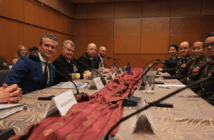Welcome to the CavasShips Podcast with Christopher P. Cavas and Chris Servello…a weekly podcast looking at naval and maritime events and issues of the day – in the US, across the seas and around the world. This week…One of the most difficult parts of the new build and maintenance process is having the right understanding of the condition of all the vessels’ hidden parts and pieces–welds, pipes, tanks and many other covered hardware. Gecko Robotics, a Pittsburgh based company, is helping the Navy solve this problem by using magnetic robots to map these parts and help determine their wear and need for maintenance. Troy Demmer, Gecko’s co-founder joins us to discuss how his company and the Navy are making predictive maintenance more predictive and cost effective.
Please send us feedback by DM’ing @CavasShips or @CSSProvision or you can email chriscavas@gmail.com or cservello@defaeroreport.com.
This Week’s Naval News:
Twelve Flight I Arleigh Burke-class destroyers are receiving life extensions, the US Navy announced October 31st. Originally slated for service lives of 35 years, the ships will be extended from one to five years, at an overall cost, the Navy said, of about $1.3 billion. Funding for the extensions will appear in the Fiscal Year 2026 budget request. The move follows a similar plan announced in August 2023 to extend four destroyers. The ships in the new request, USNI News reported, are the destroyers JOHN PAUL JONES, CURTIS WILBUR, STOUT, JOHN S McCAIN, LABOON, PAUL HAMILTON, GONZALEZ and COLE, all of whom will receive five-year extensions. Two ships, the BARRY and THE SULLIVANS, will be extended by three years, while the STETHEM and CARNEY will receive one-year extensions. Counting the 2023 announcements, four other Flight One ships, so far, have not been extended. USS ARLEIGH BURKE, the first of the class, was commissioned in 1991 and has already been upgraded and extended. To date, no Arleigh Burke-class ship has been decommissioned.
For the first time, China’s two active aircraft carriers, the LIAONING (Lee-au-Nung) and SHANDONG, exercised together, China announced October 31st. The carriers were joined by 11 surface warships during the exercises held in the South China Sea. A week earlier, the LIAONING transited north through the Taiwan Strait between mainland China and Taiwan. On October 29th, France announced one of its warships passed through the strait but did not identify the ship. The frigate PRAIRIAL, however, is known to have been operating in the western Pacific shortly before the announced transit.
In old ship news, the US Navy’s floating science platform FLIP, towed away last year for scrapping in Mexico, has appeared in southern France and is being refurbished by the UK-based undersea research company DEEP. The company announced the acquisition on October 23, months after buying the platform from the scrapper and apparently timed with the craft’s arrival under tow at a port near Toulon, France. The distinctive 355-foot-long FLIP – an acronym meaning Floating Instrument Platform and officially described as a “spar buoy” – was able to transition from a horizontal position to vertical, allowing scientists and technicians to conduct research and tests below the waves. DEEP said the un-powered craft, which first entered service in 1962, is expected to be operational by 2026.




